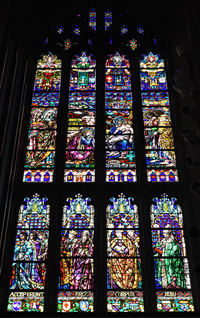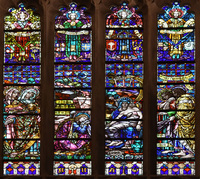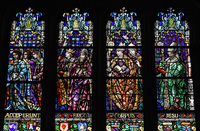Window
Building Name: Cathedral of the Most Blessed SacramentStudio Name: Willet Hauser Architectural Glass
City: Detroit
Window Shape: 6 (gothic arched, more than 2 vertical sections)
Subject/Title of Window: The Burial of Christ
Brief Description of Subject: The canopy of this apse window is strictly decorative in nature.
At the top of all of the apse windows are beautifully done angels holding a scroll and shields at their feet. The inscriptions on the scrolls prefigure that the Messiah would suffer and die for us. Panel one: Psalm 60:20-21 "I LOOKED FOR SOME PITY BUT THERE WAS NONE .... They gave me gall for my meat and in my thirst they gave me vinegar to drink." Panel 2: Psalm 69:20 "YET IT PLEASED THE LORD TO BRUISE HIM; he hath put him to grief .... Christ by offering up himself will give life to his Church, and cause them to live forever." Panel 3: Luke 2:35 "A SWORD SHALL PIERCE THINE OWN HEART (soul)." Panel 4: Isaiah 53:4 "SURELY HE HATH BORNE OUR GRIEFS, and carried our sorrows .... but he was wounded for our transgression .... And the Lord hath laid on him the inequity of us all." The angel in the third panel has the Hebrew letters for "Yahweh" (God) inside a triangle (symbol for the Trinity) and the angel in the second panel wears a medallion containing a tau-rho cross (Jesus on the cross).
The rendering of the burial of Jesus surrounded by mourners is known as the "Lamentation of Christ" and was a popular subject in the Norman era. The various inscriptions seen here all pertain to the Lamentation and are found in John 19:37-41 of the Douay-Rheims version of the Bible. "And again another scripture saith: They shall look on him whom they pierced. And after these things, JOSEPH OF ARIMATHEA (because he was a disciple of Jesus, but secretly for fear of the Jews) BESOUGHT PILATE that he might TAKE away the BODY OF Jesus. And Pilate gave leave. He came therefore, and took the body of Jesus. And Nicodemus also came, (he who at first came to Jesus by night,) bringing a mixture of myrrh and aloes, about an hundred pound weight. THEY TOOK THEREFORE THE BODY OF JESUS, and bound it in linen cloths, with spices, as manner of the Jews to bury. NOW THERE WAS IN THE PLACE where he WAS CRUCIFIED, a garden; and in the garden A NEW SEPULCHRE, wherein NO MAN yet had been laid."
This pose of the Virgin Mary with the dead body of her son Jesus is known as "Pieta" (Italian for "pity").The crown of thorns is now at the feet of Jesus. The sepulcher is located next to the kneeling Mary Magdalene. The Gospel of John indicates the location of the burial was near where he was crucified, thus the three crosses on a hill in the background. Both the Gospels of Mark and John have the burial taking place at night, this is shown by the crescent moon in the second panel. At the bottom of the scene there are symbols inside the arches. The outer arches contain decorative symbols while the inner arches contains what looks like a monstrance with a consecrated host and a lit candle (Christ is the light of the world) surrounded by the Greek letters "XC IC" (Christ Jesus normally seen as "IC XC" Jesus Christ) and Alpha and Omega (God the beginning and end of all things).
Below the scene are bishops, a king, and followers of Christ. The drapery on the bishops in the third and fourth panels are worth noting. The bishop in the green drapery is wearing an encolpion Below the inscription are shields. The first four contain Christian symbols while the last four appear to be decorative.
From the Guide to the Cathedral of the Most Blessed Sacrament, Copyright 1958, Archdiocese of Detroit.
The disciples and holy women prepare Christ’s body for burial in the tomb given by Joseph of Arimathea. The first panel depicts the women with spices for the embalming. In the second Mary Magdalene weeps disconsolately, in the third the Sorrowful Mother holds the body of her dead Son in her arms. The last panel pictures Joseph of Arimathea.
Inscriptions: ACCEPERUNT ERGO CORPUS JESU
Therefore they took the body of Jesus.
Height: 25'
Width: 8.5'
The Burial of Christ
The Burial of Christ, scene
The Burial of Christ, bottom
The MSGC is a constantly evolving database. Not all the data that has been collected by volunteers has been sorted and entered. Not every building has been completely documented.
All images in the Index are either born-digital photographs of windows or buildings or are scans of slides, prints, or other published sources. These images have been provided by volunteers and the quality of the material varies widely.
If you have any questions, additions or corrections, or think you can provide better images and are willing to share them, please contact donald20@msu.edu





